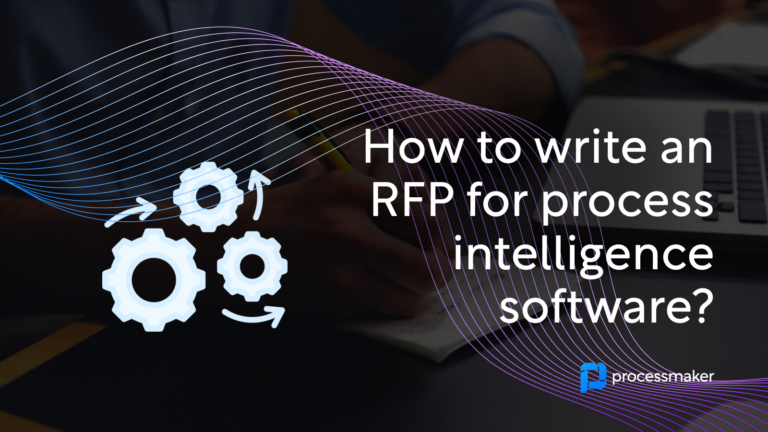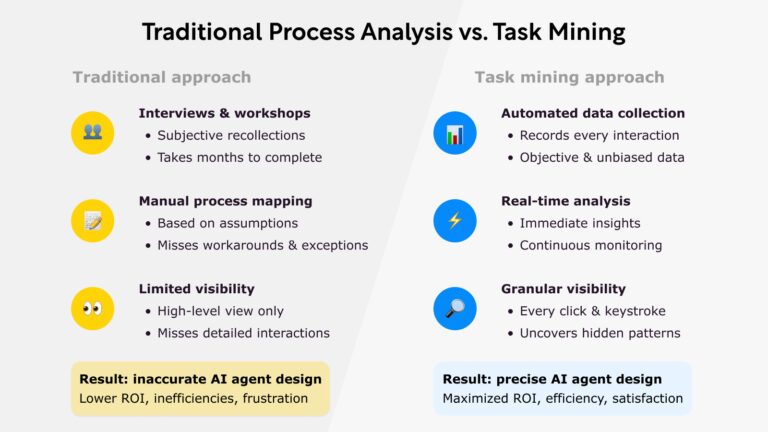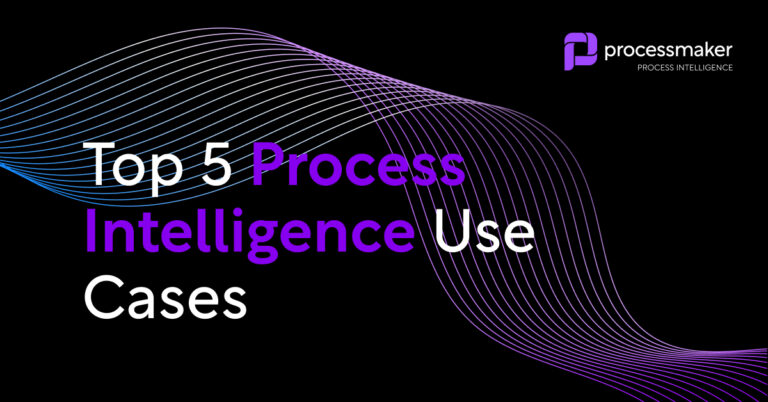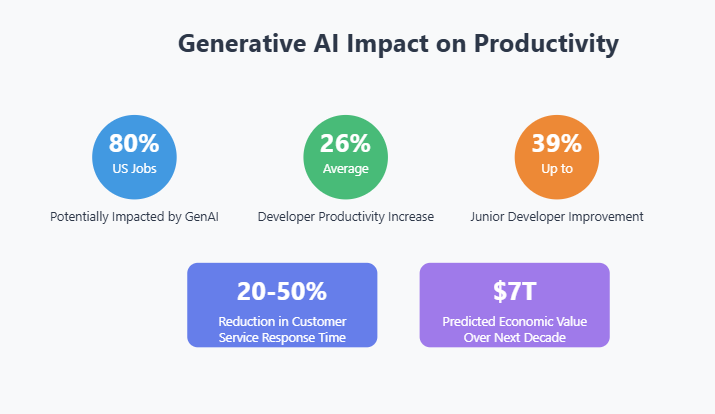Do you need a process intelligence solution and want to find the right vendor to suit your needs? Then it’s time to develop a request for proposal (RFP.) A well-planned and written RFP will help you find answers and compare vendors to find your ideal software provider. But how do you write an RFP for process intelligence software?
At ProcessMaker, we have decades of combined experience developing, implementing, and improving enterprise processes. We like to think we thrive at the cross-section of enterprise automation and process intelligence, and we’ve seen our fair share of RFPs, RFQs, and RFIs over the years. We’ve written this guide to help you with your aim of enabling a perfectly optimized enterprise.
When to request an RFP?
Before you start, deciding whether an RFP is the best option for your process intelligence or process mining needs is essential.
A request for proposal is a document that you create when you’re seeking out and evaluating multiple bids for one or more solutions or procured items. Typically they are used when you need a solution with more technical expertise or a specialized approach for unique business needs.
RFPs are a common practice in enterprise software, but they are not the only option. You can also explore free or paid trials, proof of concept, or simply request information directly from different vendors. In some organizations, RFPs are simply a common part of a procurement process.
Getting ready for your RFP
Shortlist your vendors
Before starting your RFP, make a shortlist of vendors. The final list should include at least two vendors you’re confident are right for you. Getting the hottest vendors on the shortlist requires deep research into the marketplace and evaluating them based on your needs. Reading customer reviews, write-ups in magazines, and booking free demos will make it easier for you to make the right choice.
Remember, though, that it’s not just your or your department’s choice. Writing an RFP for process intelligence software requires internal alignment, especially while looking for the right vendor.
Some key stakeholders you may want to include in drafting an RFP for process intelligence:
- Process / Operational Excellence
- Shared Services / Global Business Services
- Finance
- IT
- Procurement
- Enterprise Digital Strategy / Transformation
Remember, only you and your company truly know what you require from your software. Asking the vendor the right questions gives them a better idea of what you want and how they can help. The best response from a vendor is one with enough information for you to think about but not so much that reviewing your choices becomes too time-consuming.
Create a Scoring Criteria
Even in an ideal world, an RFP can be a time-consuming process. Make sure you have a clear framework of scoring from the start – this way, your evaluation time down the line will be smoother.
You’re likely to see different strengths and weaknesses from the responses from other vendors. Be sure to define and agree on the selection criteria before creating and issuing your RFP.
Some critical RFP scoring criteria to consider:
- Are you looking for a process mining, task mining, or full-feature process intelligence solution that covers systems, processes, and work?
- Are you looking for a turnkey solution requiring limited implementation or more extensive deployment resources?
- Do you have or need the capabilities to deploy the solution across your organization, or will you require extensive support from the vendor or one of their partners?
- What is your timeframe and urgency for the project? Is it within weeks, months, or years?
- Are you looking for a solution that you can pilot and expand over time across your organization, or do you expect clear, measurable outcomes from the start?
- How important is the solution’s current state, and how much weight do you give the vision and future roadmap of your chosen partner?
- Can you estimate the total cost of ownership of the solution based on the proposal answers, and will it meet your budget requirements?
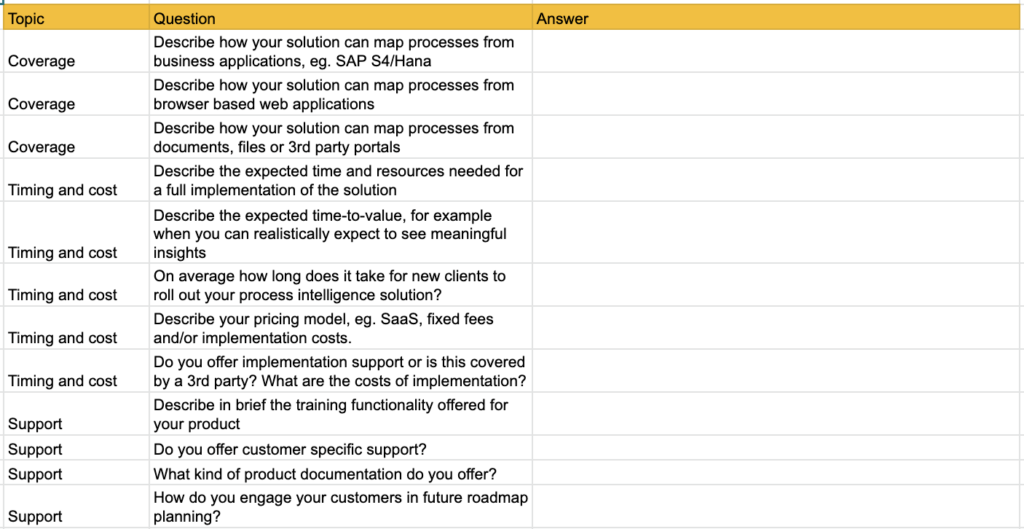
Structuring your RFP
Offer lots of background information
The more information you give the vendor, the better the vendor can meet your needs. The vendor must understand your current situation, the problems you want to solve, your project timeline, and the specific reasons you’re conducting an RFP.
Giving lots of relevant information in the early stages will steer you away from possible roadblocks and prevent you from having to answer many little questions along the way. A stitch in time saves nine.
Offer a realistic idea of the project scope and budget
As the end goal of an RFP is to understand which vendor meets your requirements, you may choose to include more specific needs for information to estimate the size of the project and pricing. These could include:
- Are you looking for a fixed or variable pricing solution based on how much it is used?
- Do you have a budget estimate or pricing range that you’d expect to see?
- Are you looking for a long-term commitment or software that you can bring in as a service?
- How many source systems of data do you plan to analyze?
- How many users, teams, or departments do you plan to include in the analysis?
- If you have a specific business use case, how much data is under analysis, for example:
- An estimate of how many invoices are processed per month.
- How many purchase orders are part of an analysis?
- How many customer service tickets are filed within the process?
- A measurable goal to reduce throughput time in a key process.
- A target for the level of automation or digitalization measured in your organization’s targets.
Give clear instructions
Give the vendor a response deadline to your RFP to ensure your project stays on schedule. To keep things consistent, you can even state your preferred format for their response, such as a Microsoft Word doc, PDF, Google Drive, etc.
Regarding consistency, the most effective way to compare vendor responses is by setting a minimum and maximum word count limit. It’s much easier to compare three separate 500-word documents than two that vary widely in content.
Keep your vendors in the loop
Let your vendor know how you’ll “grade” their work, inform them how long the selection process will last, and, of course, let them know whether or not you’ve decided to take them to the next round.
Remember to give detailed and constructive feedback to any of the vendors who don’t win the RFP. Allow the vendors to learn from the process – perhaps one day, they will be suitable partners for your developing needs.
RFP questions do’s and don’ts
Once you’ve decided the who, what, and when of your RFP, you can get into the detailed questions and evaluation criteria. Keep in mind some best practices.
Organize questions by topics
Often RFPs are shared in the form of Microsoft Excel files. In this case, it’s smart to make separate sheets and/or topics for different question areas. Giving a clear hierarchy of questions in your spreadsheet can make it quicker for answers and easier for you to rate and evaluate answers.
Sections for a process intelligence RFP could include:
- Company Overview
- Functionality
- Implementation
- Data Management
- Security
Define evaluation and selection criteria
When you define questions for an RFP, keep in mind that it isn’t intended just as a shopping list of needs. It is a tool that helps you introduce and set expectations with your potential supplier and partner.
Be as transparent as you can about how you evaluate the answers to the RFP. Share in advance if there are key questions that disqualify answers or questions that require a more detailed response. If you request additional information, be clear on their format and expected scope.
Get clear answers
Clear questions lead to clear and concise answers from vendors. Vague questions such as “How can your solution save our employees time day to day?” will result in widely varied and largely irrelevant responses.
Ask questions such as, “In two paragraphs, explain how your solution can save our employees time.” Also, remember to ask yes and no questions. One-word answers are straightforward, time-efficient, and easy to understand.
RFP for Process Intelligence
Creating well-rounded RFPs may seem like a daunting task but with these tactics and best practices, it’s easier and faster than you think. If you want to make your life easier and learn everything about process intelligence technology, along with its benefits, challenges, and use cases, read our comprehensive guide on the whats and hows of process intelligence.
